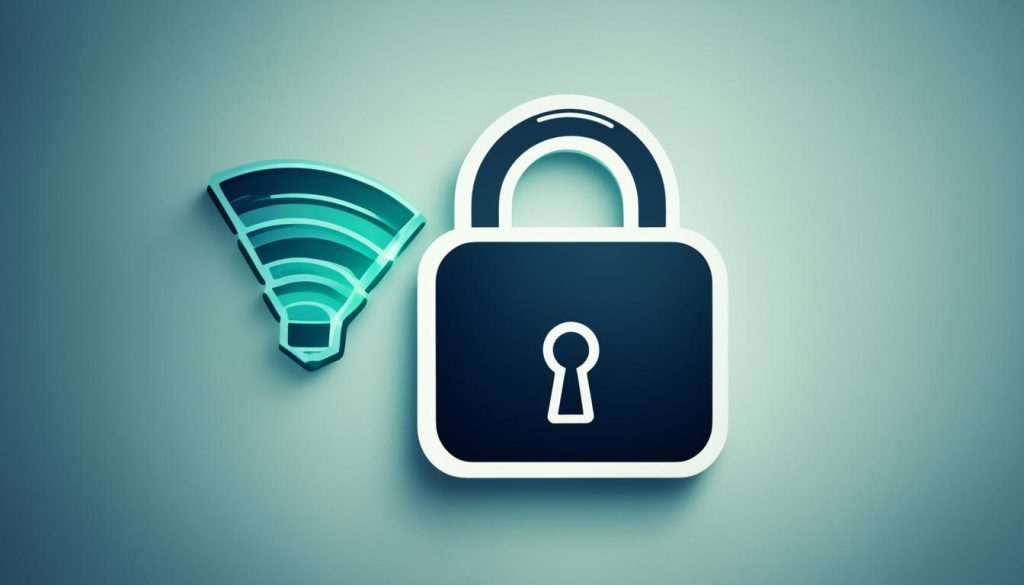In today’s digital age, teleworking has become increasingly popular, allowing individuals to work from the comfort of their own homes. However, this convenience comes with its own set of risks, particularly when it comes to the security of your home wireless network. With the rise of cyber-attacks and phishing scams, it is crucial to take proactive steps to protect your network and ensure the safety of your sensitive company information.
Securing your home wireless network is not a daunting task. By following a few simple measures, you can significantly enhance the security of your network and create a safe teleworking environment. Let’s explore the best practices for securing your home wireless network and protecting your valuable data.
Key Takeaways:
- Changing default usernames and passwords is crucial to safeguarding your home wireless network.
- Implementing encryption, such as WPA3, provides stronger security for your network data.
- Using a Virtual Private Network (VPN) adds an extra layer of security and protects your online activities.
- Optimizing network settings, updating router firmware, and enabling a network firewall is vital for network protection.
- Securing your network name (SSID) and using MAC address filtering further enhance the security of your home network.
Also read: Outsmart Jack Frost: 5 Best Ways to Protect Your Outdoor Faucets From Freezing
Change Default Username and Password
The first and most important step to secure your home Wi-Fi network is to change the default username and password provided by your Wi-Fi provider. Hackers can easily find these default passwords online and gain access to your network. By changing the username and password to something unique and strong, you make it more difficult for attackers to identify and infiltrate your network.
Why is it important to change the default username and password?
When you set up a new Wi-Fi router, it usually comes with a default username and password. The problem is that these default credentials are widely known and easily accessible through online databases. Hackers can simply search for your router’s model and find the default login information. By not changing the default username and password, you are essentially leaving your network vulnerable to unauthorized access.
Changing the default username and password is a simple yet effective way to enhance the security of your home Wi-Fi network. By choosing a unique username and a strong password, you make it much harder for attackers to gain entry into your network. A strong password should be a combination of uppercase and lowercase letters, numbers, and special characters. It should also be at least 12 characters long to ensure maximum security.
How to change the default username and password
Changing the default username and password for your Wi-Fi network depends on the router model and software you have. However, the process is generally straightforward and can be done by accessing your router’s administration panel through a web browser.
- Open a web browser on a computer or mobile device that is connected to your home Wi-Fi network.
- Type your router’s IP address in the address bar (e.g., 192.168.0.1) and press Enter.
- Enter the current username and password if prompted. If you haven’t changed them before, use the default credentials provided by your router’s manufacturer.
- Navigate to the settings or administration section of your router’s interface.
- Look for the options to change the username and password.
- Enter your new username and password, following the recommended guidelines for a strong password.
- Save your changes and exit the router’s administration panel.
After changing the default username and password, make sure to update your Wi-Fi network settings on all connected devices to reflect the new credentials. This ensures that all devices can continue to connect to the network securely.
Benefits of changing the default username and password
Changing the default username and password for your home Wi-Fi network provides several key benefits:
- Enhanced security: By using a unique username and strong password, you significantly reduce the risk of unauthorized access to your network.
- Protection against cyber attacks: Changing the default credentials helps prevent common cyber attacks, such as dictionary attacks and brute force attacks.
- Peace of mind: By taking the necessary steps to secure your home Wi-Fi network, you can work, browse, and stream online with confidence, knowing that your network is protected.
Remember that changing the default username and password is just the first step in securing your home Wi-Fi network. Implementing additional measures, such as encryption, using a VPN, and optimizing network settings, will further enhance the security of your network and safeguard your sensitive information.
| Default Username and Password | Consequences |
|---|---|
| admin/admin | High risk of unauthorized access and potential data breaches. |
| admin/password | Easy access for hackers and compromised network security. |
| admin/123456 | Weak security measures and vulnerability to cyber-attacks. |
Changing the default username and password should be the first step you take when setting up a new Wi-Fi network. By doing so, you can significantly reduce the risk of unauthorized access and protect your home network from cyber threats.
Implement Encryption with WPA3
Data security is of utmost importance when it comes to your home Wi-Fi network. To ensure that your network remains protected from unauthorized access, it is crucial to implement encryption. When it comes to encryption, WPA3 is the most secure option for your wireless network. Compared to older encryption methods like WPA or WEP, WPA3 offers stronger security measures to safeguard your network and data.
By checking the network settings of your Wi-Fi router, you can enable WPA3 encryption. This will ensure that all data transmitted between your devices and your Wi-Fi network is encrypted, making it extremely difficult for hackers to intercept and decipher the information.
WPA3 encryption provides enhanced security features, such as individualized data encryption, which adds an extra layer of protection to the network. It also protects against brute-force password attacks, ensuring that even if someone tries to gain unauthorized access, they will face significant obstacles.
To enable WPA3 encryption, access your router’s settings through your web browser and navigate to the wireless security settings. Look for the encryption options and select WPA3 as the preferred encryption method. Once enabled, all devices connecting to your network will need to support WPA3 encryption to establish a secure connection.
Keeping your network secure with the latest encryption technology is crucial in maintaining network data security. The use of WPA3 encryption provides robust protection against cyber threats, ensuring that your wireless network remains secure and your data stays confidential.
Use a Virtual Private Network (VPN)
A Virtual Private Network (VPN) is an essential tool for securing your home network and ensuring a safe teleworking experience. By encrypting your data and changing your IP address, a VPN provides a secure and private way to communicate over an unsecured network. Let’s explore the benefits of using a VPN for secure teleworking, online privacy, and remote network access.
The Benefits of Using a VPN
Using a VPN offers several advantages for securing your home network and protecting your online activities:
- Enhanced Security: A VPN encrypts your data, making it unreadable to hackers and other malicious actors. This ensures that your sensitive information remains secure, even when connected to an unsecured network.
- Anonymous Browsing: By changing your IP address, a VPN masks your online identity, making it difficult for others to track your internet activities. This enhances your online privacy and protects your personal information from being tracked or monitored.
- Access to Restricted Content: Many VPNs allow you to bypass geo-restrictions and access content that may be blocked in your location. This can be especially useful when working remotely and needing to access resources or websites that are otherwise inaccessible.
- Remote Network Access: With a VPN, you can securely connect to your company’s network or other private networks from anywhere in the world. This enables seamless remote working and ensures that your data is transmitted safely.
Choosing the Right VPN
When selecting a VPN for your home network, consider the following factors:
- Security Protocols: Look for a VPN that supports secure protocols like OpenVPN or IKEv2/IPSec. These protocols provide strong encryption and ensure a high level of security for your network.
- Server Locations: The more server locations a VPN offers, the more options you have for routing your internet traffic. This can help access geo-restricted content or maintain optimal network performance.
- Speed and Performance: Consider a VPN that provides fast connection speeds and minimal latency. This is important for maintaining a smooth teleworking experience and ensures that your internet activities are not negatively impacted.
- User-Friendly Interface: Choose a VPN with a user-friendly interface that is easy to set up and navigate. This will make it more convenient for you to connect to the VPN and manage your network settings.
Optimize Network Settings and Firewall
Regularly updating your router’s firmware, enabling the network firewall, and configuring security settings are vital for maintaining a secure home wireless network. By optimizing your network settings, you can ensure that your home network has the latest security features and protection.
Here are a few ways to optimize your home network settings and firewall:
- Router Firmware Update: It is crucial to regularly update your router’s firmware to patch vulnerabilities and improve network security. Firmware updates are released by router manufacturers to address any identified security issues or weaknesses in the router’s software. By keeping your router’s firmware up to date, you ensure that you have the latest security patches and features.
- Enabling the Network Firewall: The network firewall acts as a barrier between your home network and the outside world, monitoring incoming and outgoing network traffic for any suspicious activity. By enabling the network firewall, you add an extra layer of protection against network attacks, such as unauthorized access attempts and malware.
- Configuring Security Settings: Take the time to configure the security settings of your router and network devices. This includes setting up strong passwords for your Wi-Fi network, enabling network encryption, and disabling any unnecessary network features or services that could potentially be exploited by attackers. By customizing these settings, you enhance the security of your home network and reduce the risk of unauthorized access.
- Wi-Fi Network Configuration: When configuring your Wi-Fi network, it is recommended to use the latest security protocol (WPA3) and a strong password. Additionally, consider disabling SSID broadcasting, which hides your network name from being visible to nearby devices. This makes it more difficult for attackers to identify your network and launch targeted attacks.

Benefits of Optimizing Network Settings and Firewalls
| Benefits | Explanation |
|---|---|
| Enhanced Network Security | Regular firmware updates and enabling the network firewall provide enhanced protection against network attacks. |
| Latest Security Features | Updating router firmware ensures you have the latest security patches and features. |
| Reduced Risk of Unauthorized Access | Configuring security settings, such as strong Wi-Fi passwords and disabling unnecessary features, reduces the risk of unauthorized access to your network. |
| Greater Privacy | Utilizing Wi-Fi network configuration options like WPA3 and hiding the SSID provides increased privacy and protection against targeted attacks. |
Secure Network Name (SSID) and MAC Address Filtering
When it comes to securing your home network, there are a few additional steps you can take to enhance its protection. Changing your network name (SSID) from the default and hiding it can add an extra layer of security to your network. Additionally, utilizing MAC address filtering allows you to specify which devices are authorized to connect to your network, further enhancing its security.
Changing your network name (SSID) is a simple yet effective way to increase the security of your home network. By default, routers come with a generic network name that may give potential hackers information about the type of router you have. By changing the name to something unique, you hide this valuable piece of information, making it harder for attackers to identify your network and gain unauthorized access.
Another security measure you can take is enabling MAC address filtering. Every network device has a unique MAC address, which can be used as an additional layer of authentication. By setting up MAC address filtering on your router, you can specify which devices are authorized to connect to your network. This means that even if someone has your network name and password, they will still need to have their device’s MAC address approved before being granted access to your network.
Implementing these security measures can significantly enhance the protection of your home network against unauthorized access and potential attacks. By changing your network name (SSID) and utilizing MAC address filtering, you add an extra layer of security that strengthens your overall network defense.
Conclusion
Securing your home wireless network is essential for teleworking. By implementing the steps outlined in this article, you can enhance the security of your network and protect your sensitive data. From changing default usernames and passwords to enabling encryption and using a VPN, taking proactive measures will help create a safe and productive teleworking environment. Stay informed about emerging threats and follow best practices to maintain a secure home network.
FAQ
Why is securing my home wireless network important for teleworking?
Securing your home wireless network is crucial for teleworking, especially in the era of increased remote work. With the rise of cyber attacks and phishing scams, it’s important to take steps to protect your network and sensitive company information.
How do I change the default username and password for my home Wi-Fi network?
The first and most important step to secure your home Wi-Fi network is to change the default username and password provided by your Wi-Fi provider. Hackers can easily find these default passwords online and gain access to your network. By changing the username and password to something unique and strong, you make it more difficult for attackers to identify and infiltrate your network.
What is the best encryption method to use for my home Wi-Fi network?
Encryption is essential for safeguarding your network data. The most secure type of encryption to use for your home Wi-Fi network is WPA3. It offers stronger security measures compared to older encryption methods like WPA or WEP. By checking your network settings and selecting the best encryption method for your devices, you can ensure that your data remains encrypted and protected from hackers.
How does using a VPN enhance the security of my home network?
A VPN provides a secure and private way to communicate over an unsecured network. It encrypts your data and changes your IP address, making it difficult for hackers to track your online activities. Using a VPN not only enhances the security of your home network but also allows you to work remotely with peace of mind, knowing that your data is protected.
What steps should I take to optimize my home network settings?
Regularly updating your router’s firmware, enabling the network firewall, and configuring security settings are vital for maintaining a secure home wireless network. Router firmware updates patch vulnerabilities, while the firewall protects against network attacks. By optimizing your network settings, you can ensure that your home network has the latest security features and protection.
How can I add an extra layer of security to my home network?
Changing your network name (SSID) from the default and hiding it can add an extra layer of security to your home network. Hackers will find it more difficult to identify your router’s manufacturer and model, reducing the chances of an attack. Additionally, using MAC address filtering allows you to specify which devices are authorized to connect to your network, further enhancing network security.
Why is it important to secure my home wireless network for teleworking?
Securing your home wireless network is essential for teleworking. By implementing the steps outlined in this article, you can enhance the security of your network and protect your sensitive data. From changing default usernames and passwords to enabling encryption and using a VPN, taking proactive measures will help create a safe and productive teleworking environment. Stay informed about emerging threats and follow best practices to maintain a secure home network.






